Shopping for furniture pieces that embody the Japandi aesthetic, like bar stools, has been quite an exciting journey for me.
You might think a bar stool is just a bar stool, but the Japandi design opens up a whole new perspective.
It’s not just about aesthetics but functionality, quality craftsmanship, and the use of natural materials.
When I find that perfect Japandi bar stool, it feels like I’ve unearthed a gem – an embodiment of simplicity, warmth, and harmony that Japandi stands for.
Over time, I’ve developed a keen eye for recognizing the nuances that make Japandi bar stools a statement piece, not just an afterthought in the room.
I’m thrilled to share this journey with you, guiding you through what to look out for as you invite the beauty of Japandi into your space.
Here’s to creating interiors that are not just stylish, but also have a sense of tranquillity and mindfulness, just as Japandi intends.
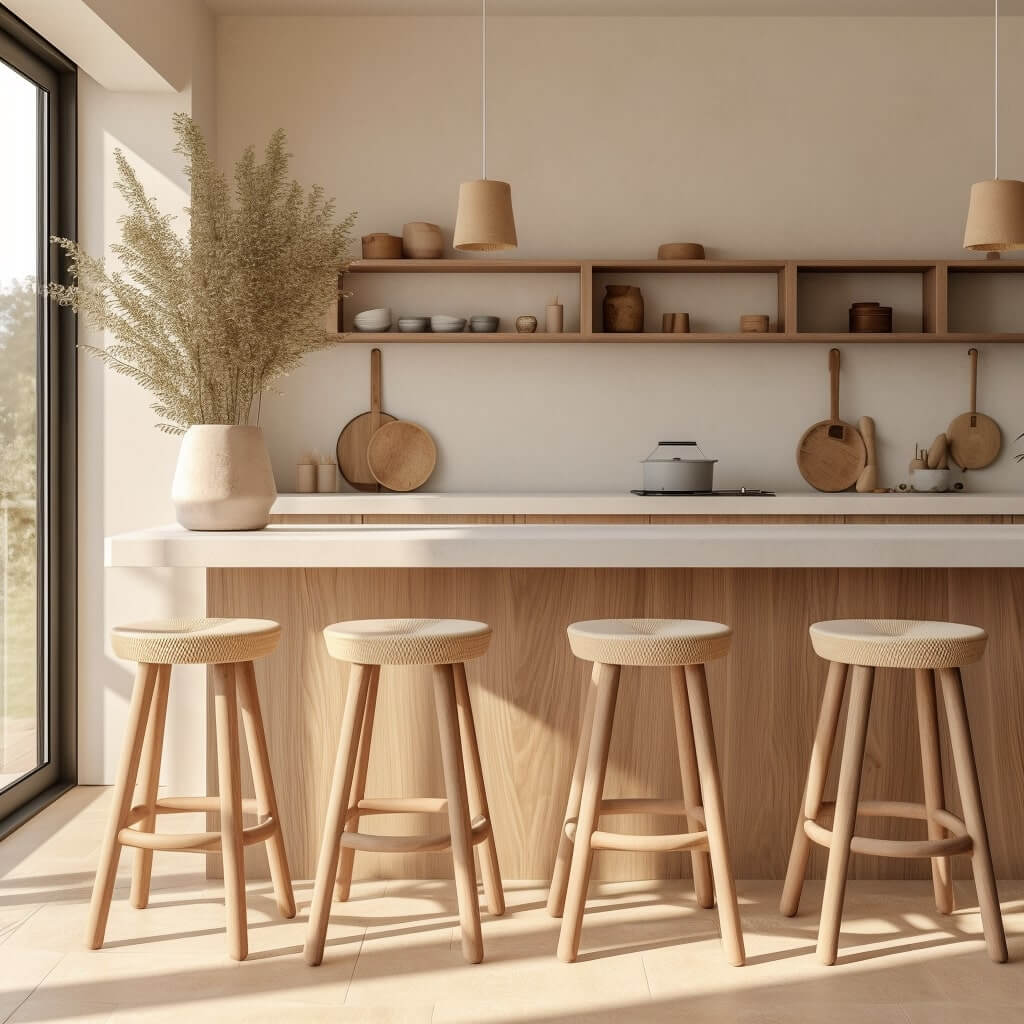
Why Choose Japandi Bar Stools?
Choosing Japandi bar stools for my clients’ projects and my own home was a decision influenced by their unique blend of functionality, simplicity, and beauty.
In my experience, their universal appeal lies in their understated elegance, making them versatile enough to seamlessly blend into any interior, whether it’s a zen Japandi kitchen or a sleek modern apartment.
Functionality is a key aspect of Japandi style, and these bar stools are no exception.
They’re designed to be comfortable and sturdy, providing an inviting spot for a quick breakfast or a glass of wine after a long day.
But more than just serving a practical purpose, they also double up as a visual treat, contributing to the room’s aesthetic appeal.
What I find especially captivating about Japandi bar stools is their ability to tell a story through their craftsmanship.
The careful selection of materials, the thoughtful design, and the impeccable execution – every element comes together to echo the principles of sustainability and authenticity that Japandi cherishes.
And let’s not forget about their transformative power.
The moment I introduce Japandi bar stools into a space, there’s an immediate shift in the atmosphere.
They bring in a sense of calm and balance that is inherent to the Japandi style.
It’s this ability to create a harmonious space where form meets function that makes choosing Japandi bar stools a decision you’re unlikely to regret.
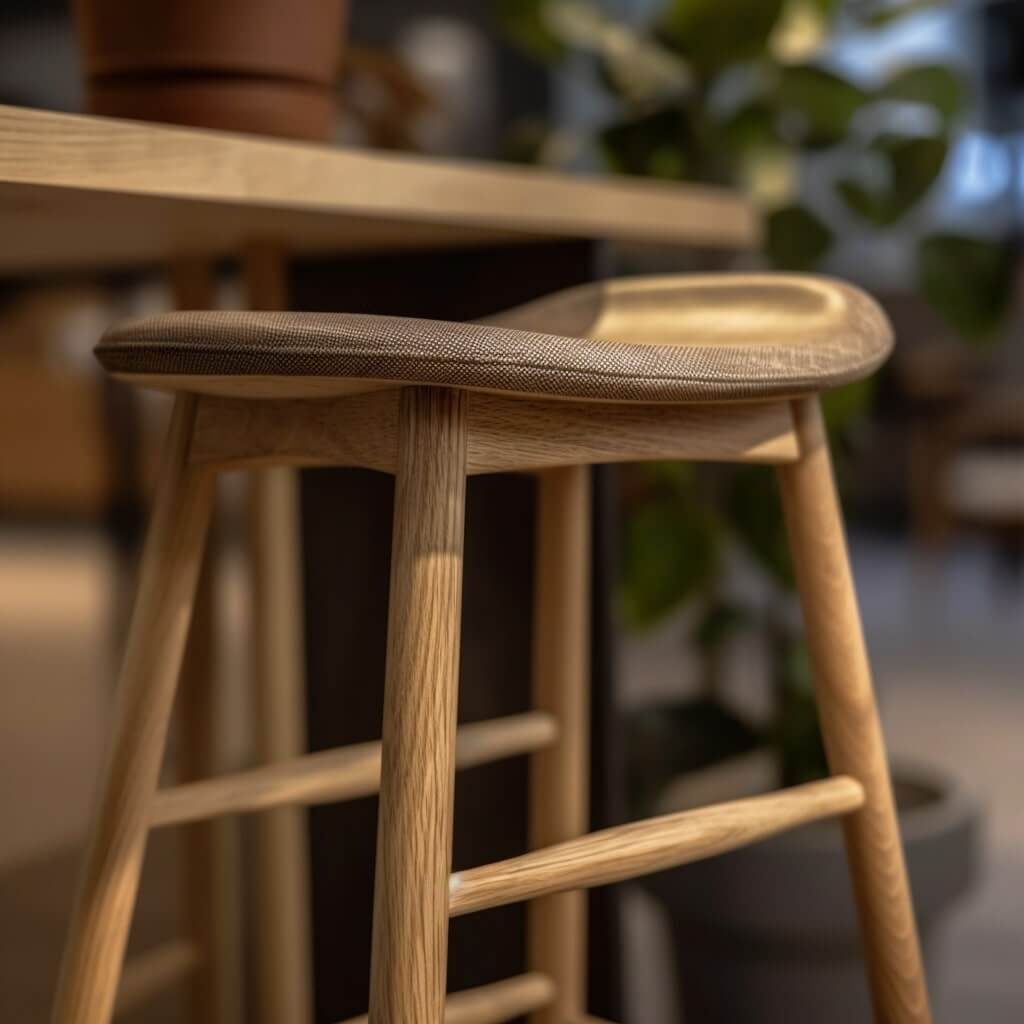
Characteristics of Japandi Bar Stools
In my years of exploring Japandi aesthetics, I’ve come to appreciate the thoughtful design principles it embodies.
When it comes to Japandi bar stools, the same principles apply: minimalist design, natural materials, neutral colors, and quality craftsmanship.
Minimalist Design
The phrase “less is more” couldn’t be more fitting for the minimalist design of Japandi bar stools.
The simplicity of these pieces is their real charm. From my experience, the stools’ designs are typically clean, fuss-free, and functional, without any unnecessary embellishments.
This minimalist approach isn’t just about achieving a sleek look; it’s also a nod towards the philosophy of living with what is necessary and cherishing each item in our space.
Every time I add a Japandi bar stool to a room, I notice how its understated elegance brings a sense of tranquility, creating a serene space that invites relaxation and comfort.
This subtlety doesn’t mean the stools are boring or bland.
On the contrary, they exhibit an elegance that speaks volumes about their design ethos, proving that you don’t need intricate patterns or bold accents to make a statement.
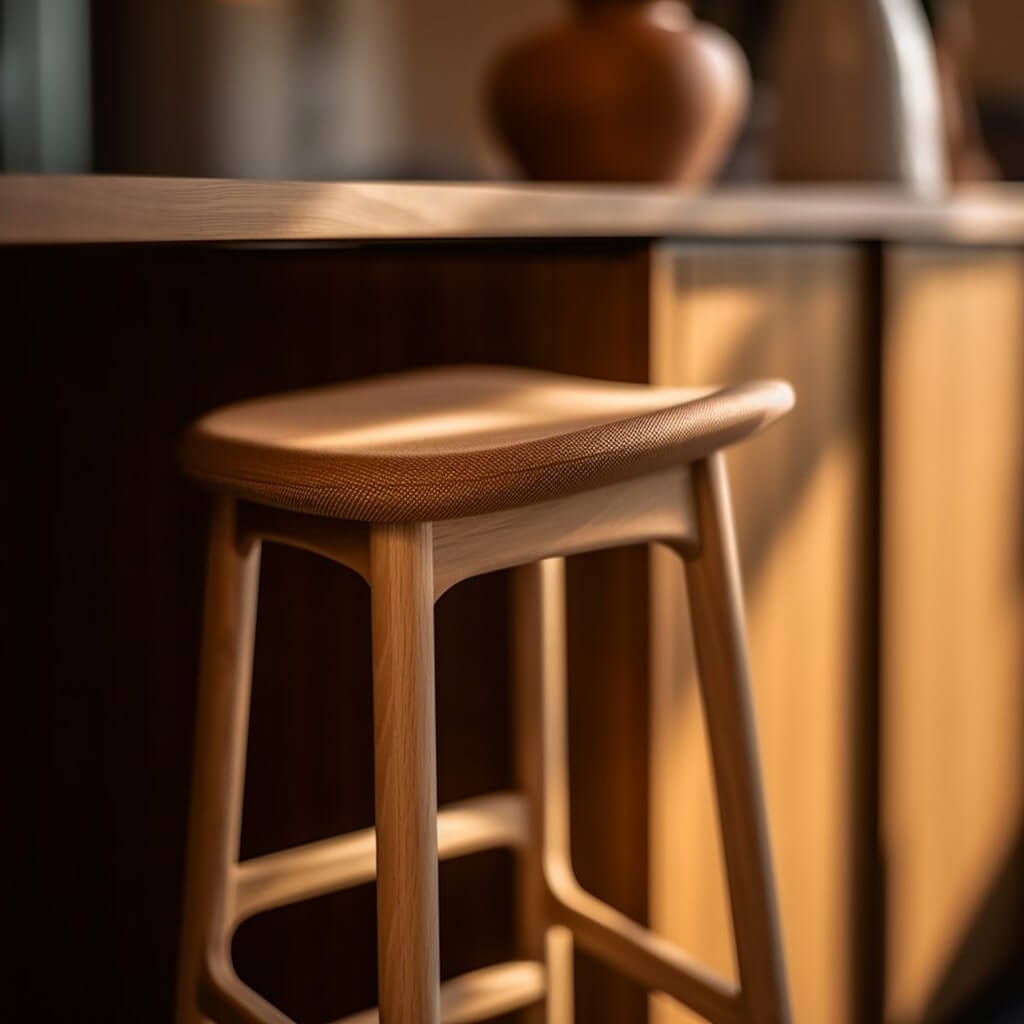
Natural Materials
A signature characteristic of Japandi design is the use of natural materials, and the same applies to bar stools.
Whether it’s wood, bamboo, rattan, or other organic materials, the choice reflects a deep respect for nature that both Japanese and Scandinavian design cultures share.
In my hunt for the perfect Japandi bar stools, I’ve found that wood, especially in its raw, unpolished form, is a common choice.
The grains, knots, and natural imperfections of the wood are celebrated, not hidden. Bamboo and rattan stools are also quite popular, their lightweight and flexible nature making them both practical and visually pleasing.
These natural materials bring a warmth and tactile quality to the stools that synthetic materials can’t replicate, reinforcing the connection with nature that Japandi aims to foster.
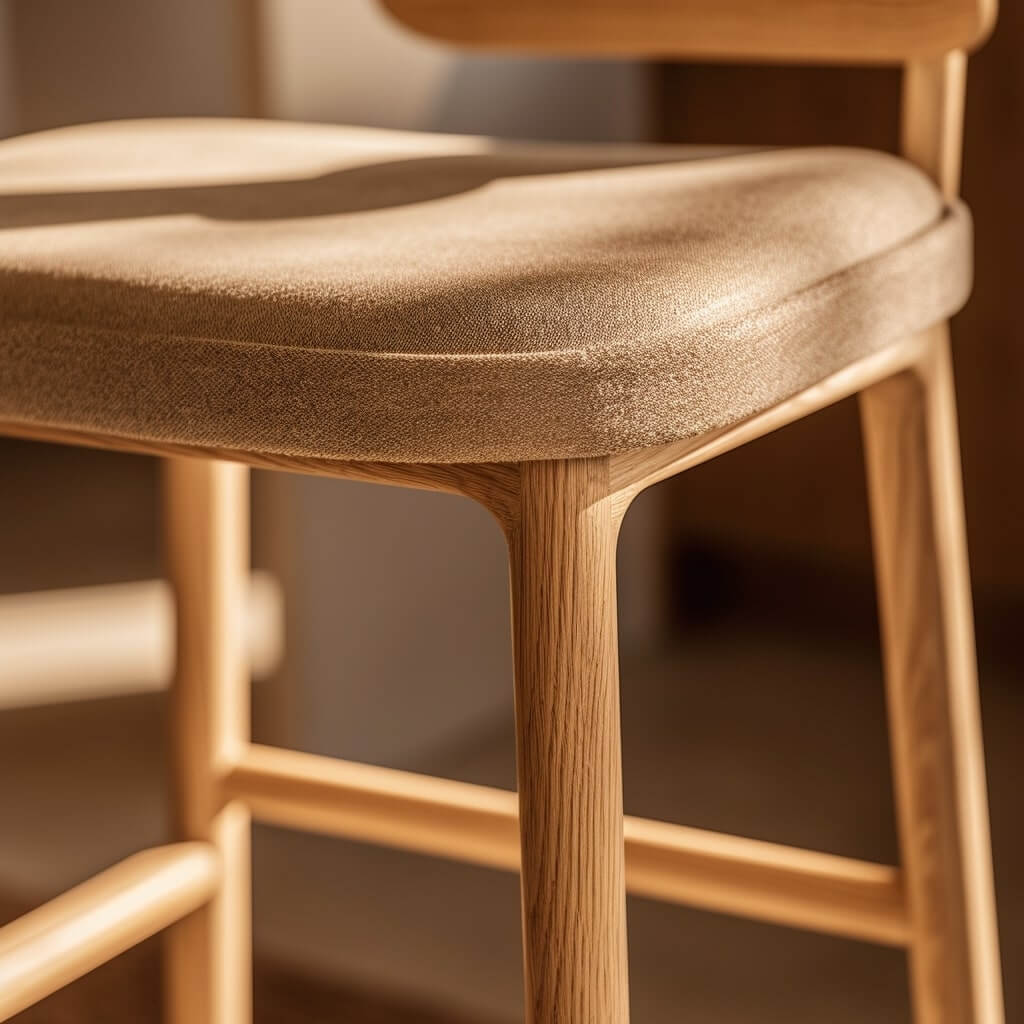
Neutral Colors
When it comes to the color palette of Japandi bar stools, think muted and calming.
The tones are usually a blend of warm and cool neutrals – think beiges, grays, whites, blacks, and occasionally, muted blues or greens.
This subdued color palette is an essential element in creating the serene and inviting ambience that Japandi interiors are known for.
In my own design projects, I’ve found that these neutral-colored stools create a sense of harmony in the space, adding to the aesthetic without overpowering it.
It’s not just about creating a minimalist look; the neutral colors also allow the beauty of the materials and the craftsmanship to shine through.
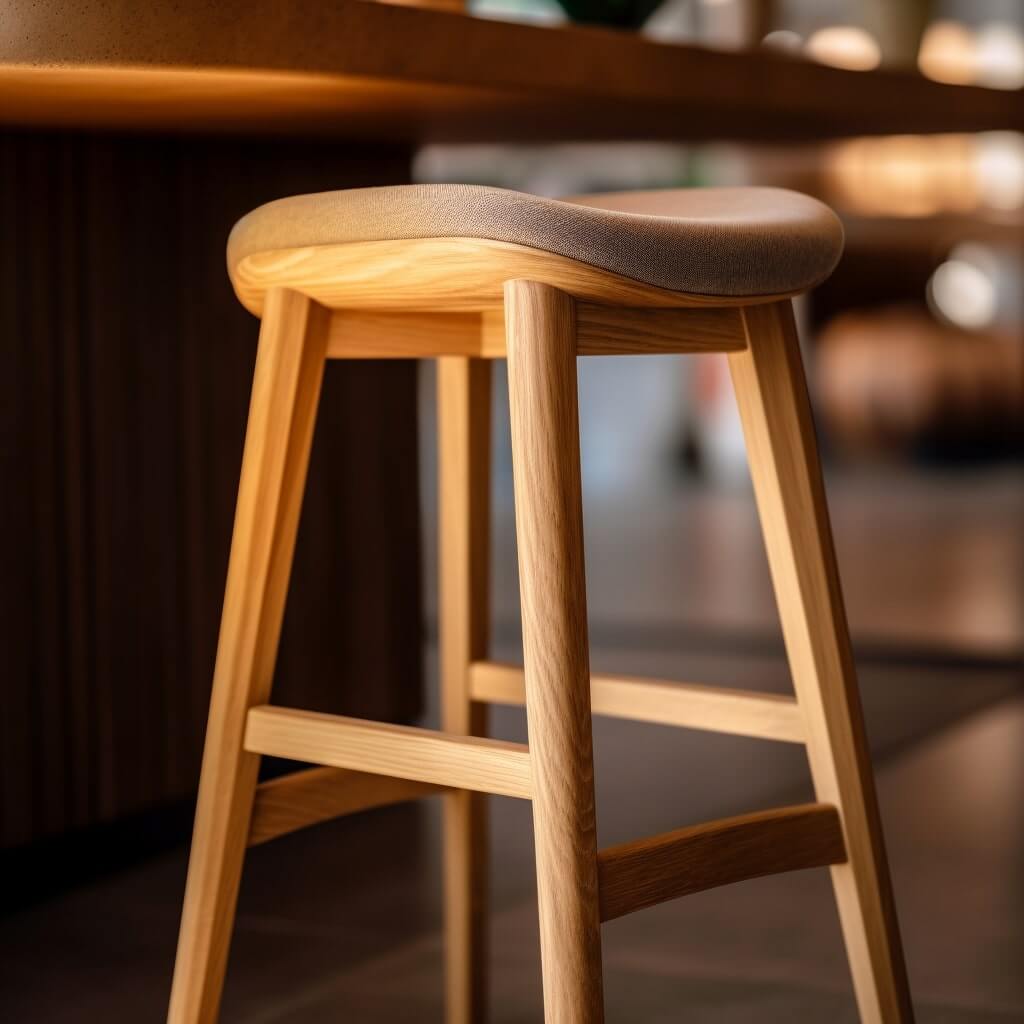
Craftsmanship
One aspect that truly sets Japandi bar stools apart is the high level of craftsmanship.
Japandi stools aren’t just products but art pieces, with every detail, every curve, and every joint speaking of the artisan’s skill and dedication.
The quality of the craftsmanship ensures not only a beautiful product but also a durable one.
In my personal and professional shopping experiences, I’ve learned to appreciate this emphasis on quality and handmade items.
It’s a testament to the Japandi ethos of sustainability and long-lasting design.
These are not disposable items; they are made to stand the test of time, to be cherished for years.
Together, these four characteristics combine to create Japandi bar stools that are as beautiful as they are functional, as serene as they are robust.
These stools, in their simplicity and elegance, reflect the heart of Japandi design, offering more than just a place to sit; they contribute to a mindful and harmonious living space.
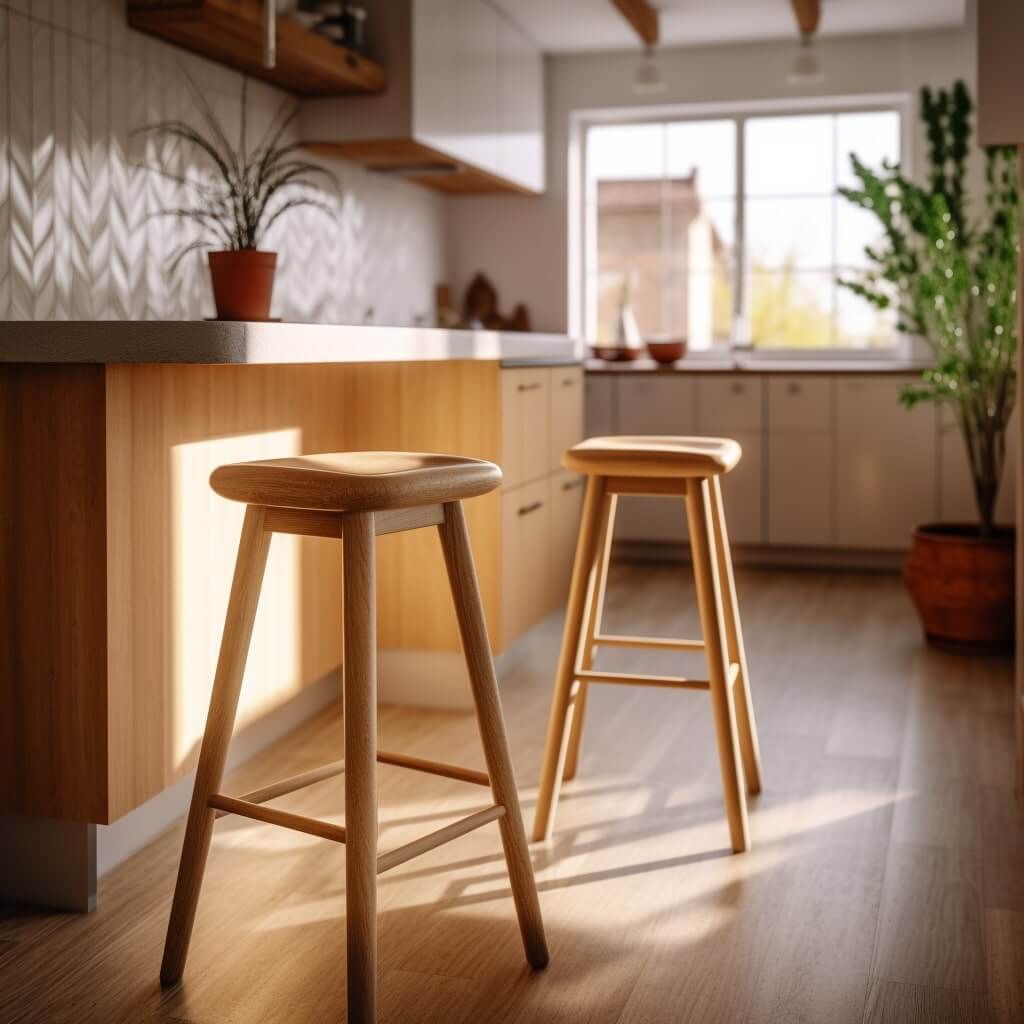
How to Choose a Japandi Bar Stool
When it comes to choosing a Japandi bar stool, I’ve learned that it’s not merely about finding a piece that fits the description, but one that complements your space and serves your needs.
From considering the existing decor, assessing the quality and durability, selecting the right size and height, to choosing the appropriate color palette, there are several aspects to keep in mind.
Considering the Room’s Existing Decor
Before choosing a Japandi bar stool, it’s important to take a good look at the room’s existing Japandi decor. Will the stool add to the room’s aesthetic or clash with it? The minimalistic and neutral nature of Japandi design usually helps it blend well with various styles, but it’s still crucial to consider the overall look you’re aiming for.
In my experience, for rooms with a modern or industrial aesthetic, I often opt for stools with metal elements or darker wood. For spaces that lean towards a more rustic or traditional style, stools made of lighter wood or rattan can add to the room’s cozy and homely feel. Remember, the bar stool isn’t a stand-alone piece; it’s a part of a larger design narrative.
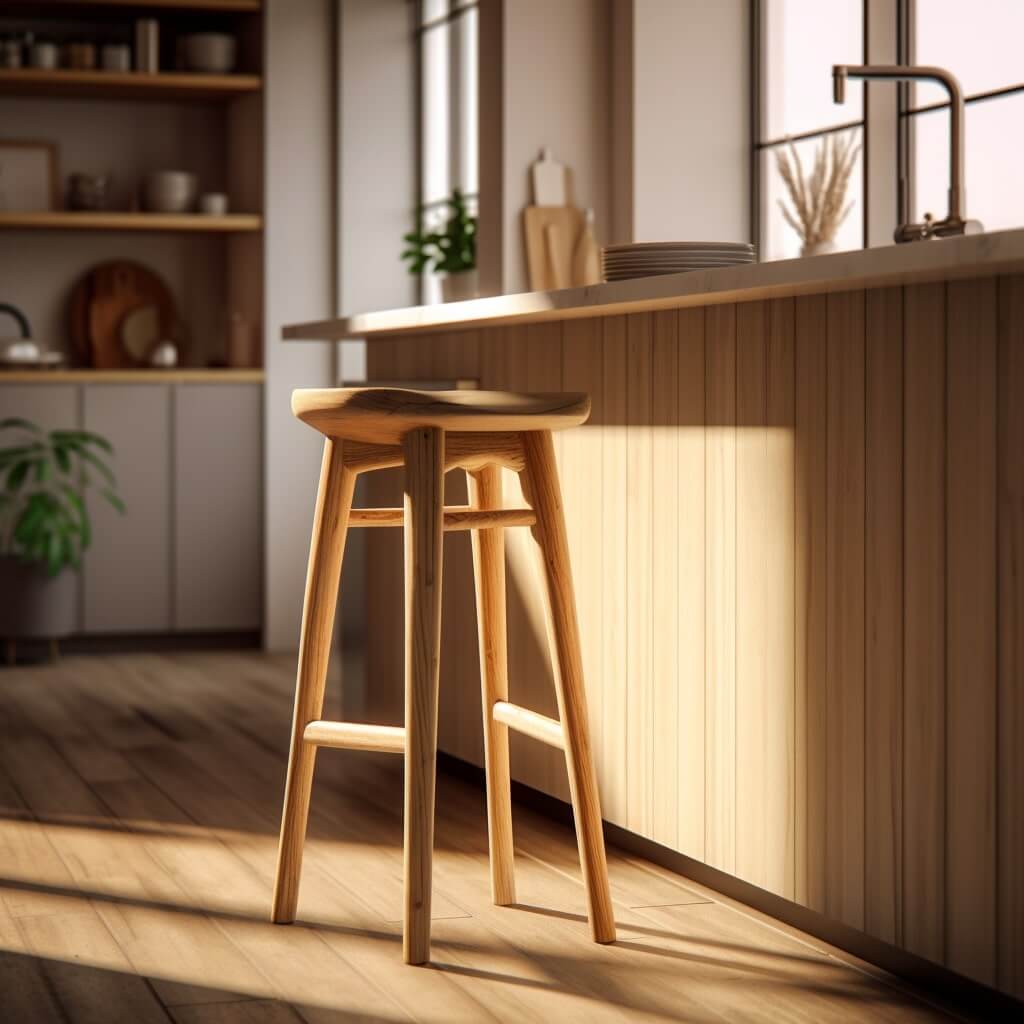
Assessing the Quality and Durability
Quality and durability should never be compromised. I always take the time to inspect the stool’s craftsmanship. Is the stool sturdy? Are the joints well-made? Are there any signs of poor construction like uneven finishes or loose parts?
Also, pay close attention to the materials used. A solid wood stool, for instance, should feel substantial and not hollow or light. For stools made from rattan or bamboo, look for tight weaves and no fraying. Quality Japandi bar stools are investments that should stand the test of time.
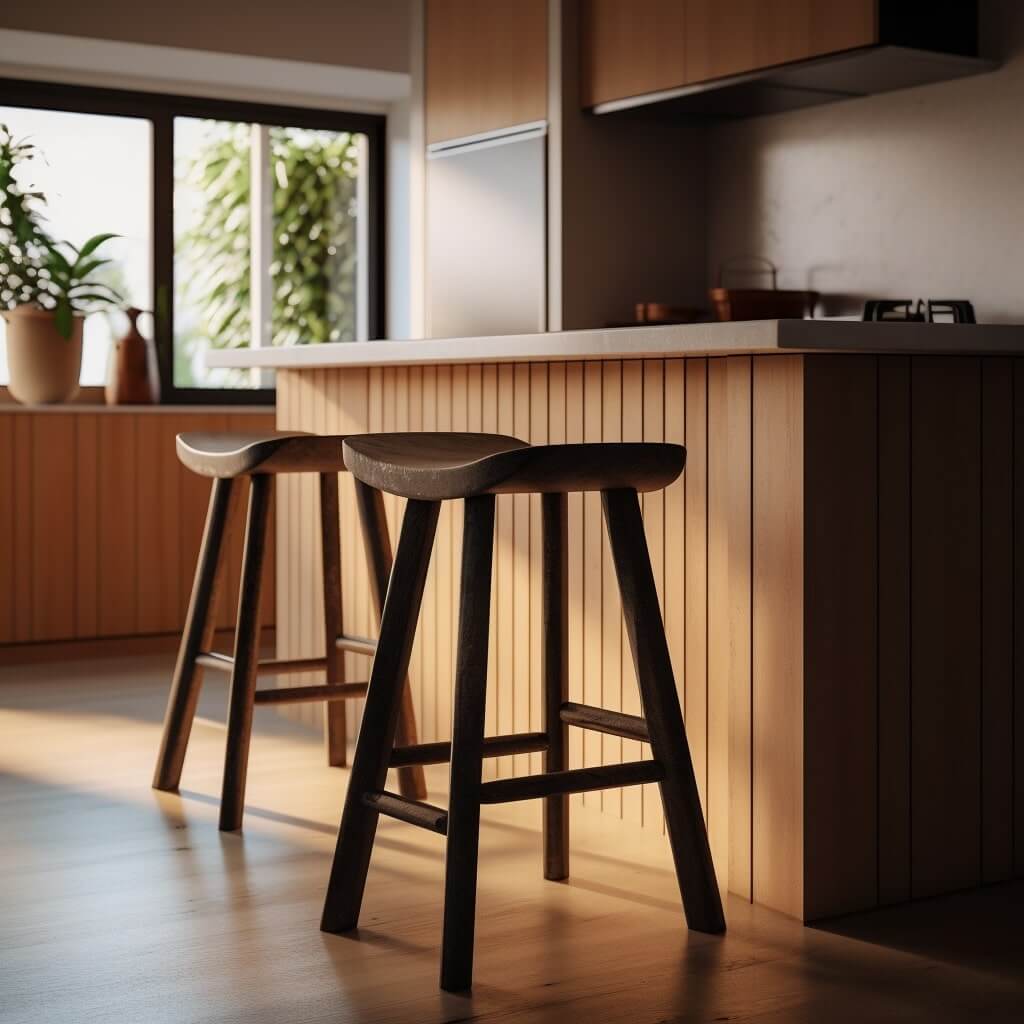
Picking the Right Size and Height
One common mistake people make when choosing bar stools is disregarding the dimensions.
To ensure comfort, it’s essential to consider the height of the counter or bar the stool will be placed under.
As a rule of thumb, there should be about 9 to 12 inches between the seat of the stool and the underside of the counter for optimal legroom.
When it comes to the width, ensure there’s enough space between each stool for people to move comfortably without feeling cramped.
This can range from 6 to 10 inches, depending on the size of the stools and the available space. The good thing about stools compared to other seating is that they use space efficiently – great for small, Japandi apartments.
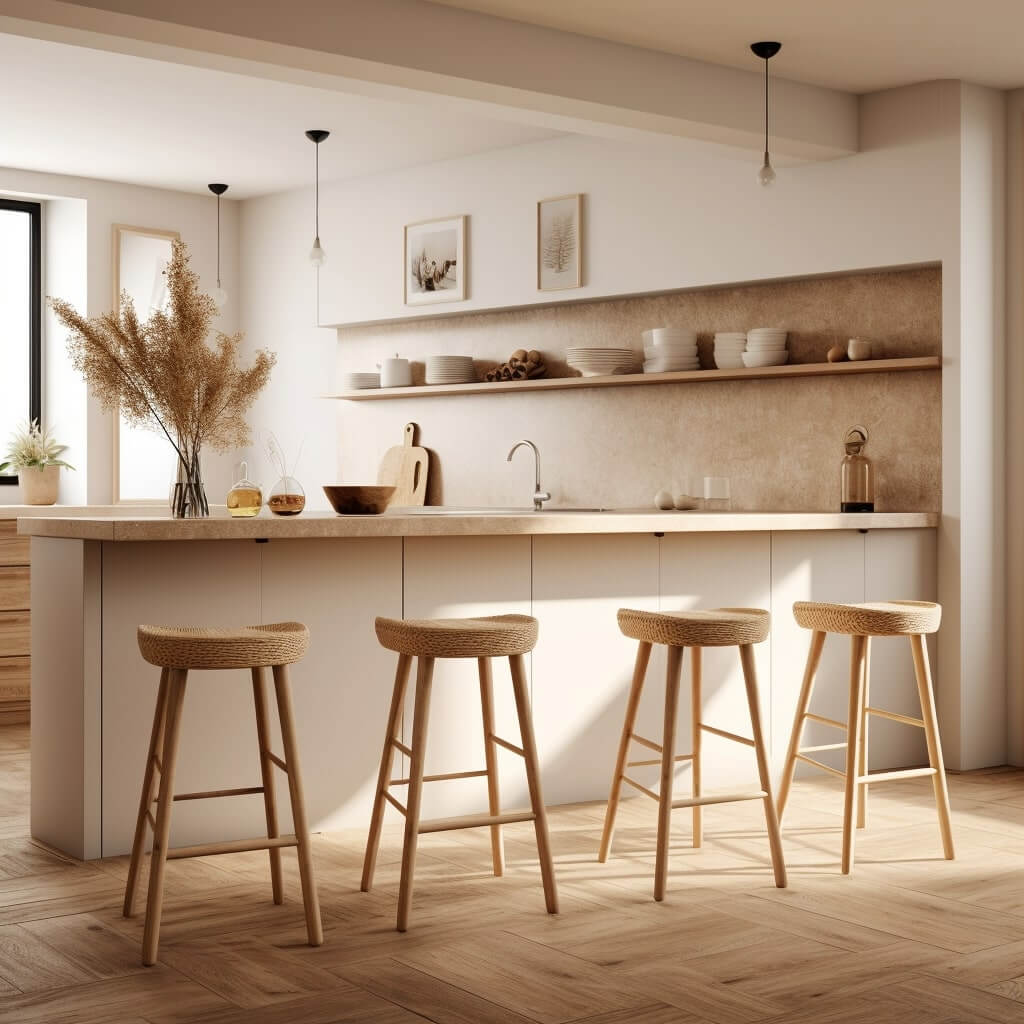
Selecting the Appropriate Color Palette
Lastly, consider the color palette. As Japandi colors are typically neutral, they can seamlessly blend with most color schemes.
However, it’s still worth considering the dominant tones in your space.
For instance, in a room with cooler tones, opt for a stool with a grey or black finish.
On the other hand, if your space has a warm color scheme, a stool in a natural wood or beige finish would blend better.
Choosing a Japandi bar stool isn’t just about aesthetics but also about making mindful choices that ensure comfort, functionality, and longevity.
Take your time, consider these aspects, and I guarantee you’ll find a stool that not only serves its purpose but also elevates your space.
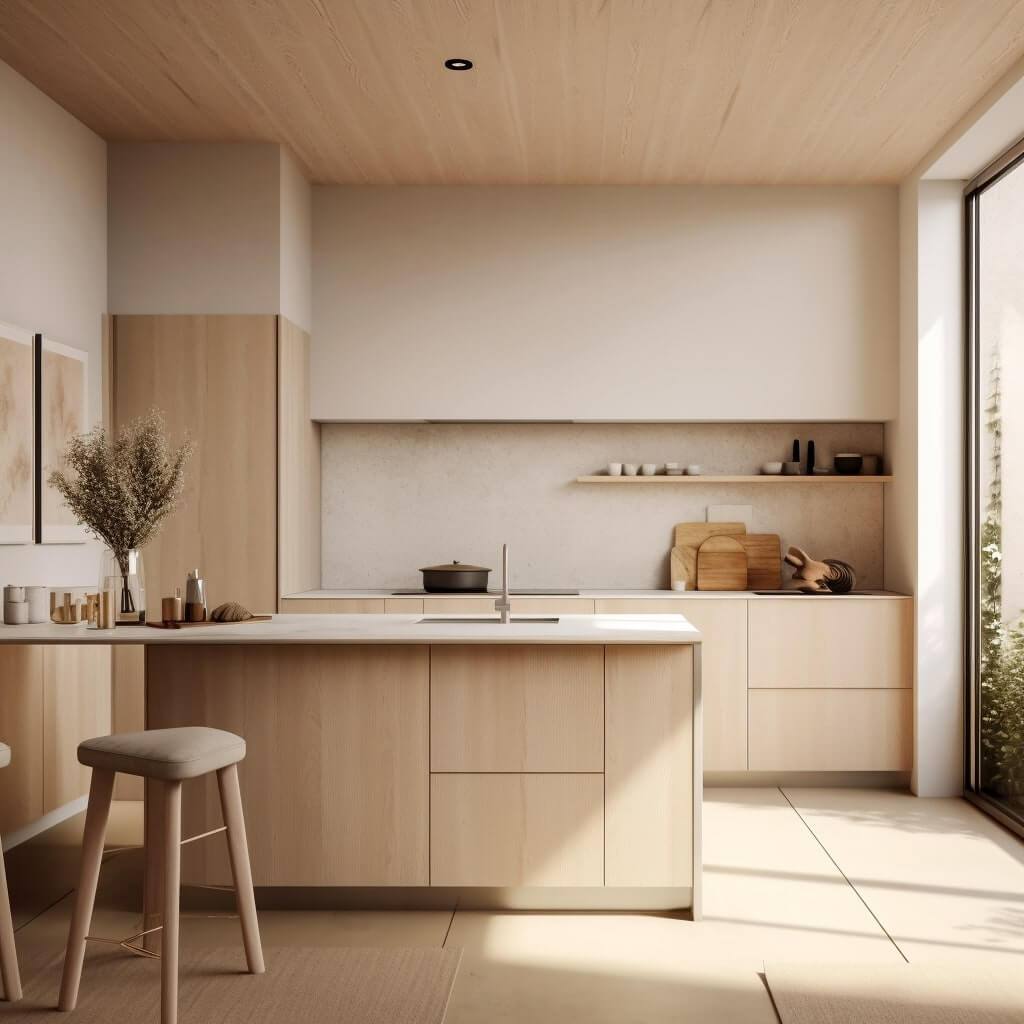
Where to Buy Japandi Bar Stools
Finding the right source to buy Japandi bar stools can be as crucial as selecting the stools themselves.
You want to ensure that the pieces you buy are not only beautiful but also of great quality.
Over the years, I’ve discovered a few go-to places, both physical stores and online platforms, where I’ve consistently found well-made, stylish Japandi bar stools.
One of my favorite places is Ikea.
While it’s more associated with Scandinavian design, they’ve embraced the Japandi trend in recent years.
Their collection often features pieces that embody the minimalism, natural materials, and functionality of Japandi design.
Plus, they offer a range of sizes and designs to suit different spaces.
For those who appreciate unique, artisanal pieces, Etsy is a treasure trove.
This online marketplace brings together craftsmen from all over the world, and you can find beautiful, handmade Japandi bar stools here.
Whether you’re looking for a bamboo stool or one made from reclaimed wood, there’s a good chance you’ll find it on Etsy.
Another reliable online store is Wayfair.
They offer a broad range of Japandi style furniture, and their selection is quite impressive.
What I appreciate about Wayfair is the detailed product descriptions and customer reviews, which can be very helpful when making a decision.
Lastly, don’t underestimate the power of local furniture stores.
Many local artisans and manufacturers embrace the Japandi aesthetic and offer quality pieces that aren’t mass-produced.
So it’s always worth exploring what’s available locally.
Remember, choosing a reputable place to buy your Japandi bar stools is key to ensuring that you get pieces that are as durable as they are beautiful.
Take your time to explore, compare, and choose the source that best fits your needs and preferences.
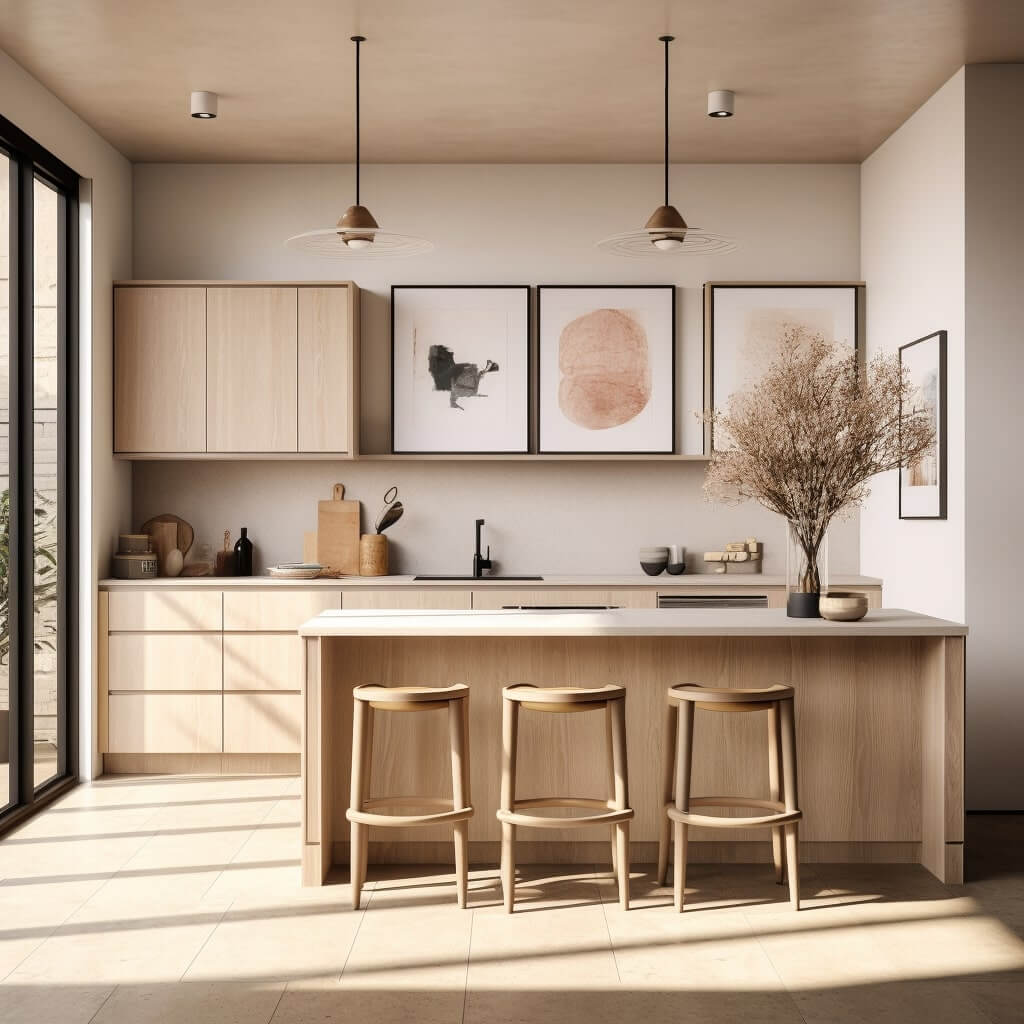
FAQs
What style of bar stool is most comfortable?
Comfort in bar stools typically comes from features like cushioned seats, backrests, and footrests. Ergonomic designs that align with the natural curve of your body can greatly enhance comfort.
Are bar stools still in style?
Absolutely! Bar stools remain a popular choice due to their versatility and functionality. They’re ideal for kitchens, home bars, and dining areas, providing informal seating that saves space and adds style.
What can I use instead of bar stools?
Alternatives to bar stools can be counter-height chairs, benches, or even standing-height tables. The choice depends on your space, aesthetic preference, and functional needs.
Are backless bar stools better?
Backless bar stools offer a sleek, space-saving design that can tuck under counters easily. However, for prolonged seating, stools with backs may provide more comfort and support.
What Makes a Bar Stool Japandi Style?
Japandi bar stools typically feature minimalist design, natural materials, a neutral color palette, and high-quality craftsmanship, reflecting both Japanese and Scandinavian aesthetics.
How Do I Care for My Japandi Bar Stool?
Care depends on the materials used. Generally, dust regularly with a soft cloth, avoid harsh chemicals, and protect from excessive moisture. For wood, periodic oiling might be required to maintain its luster.
Can Japandi Bar Stools Fit into Any Design Aesthetic?
Japandi bar stools, with their minimalist and neutral design, can blend with various decor styles. However, they may not suit highly ornate or vibrant interiors. It’s best to consider the overall aesthetic of your space.







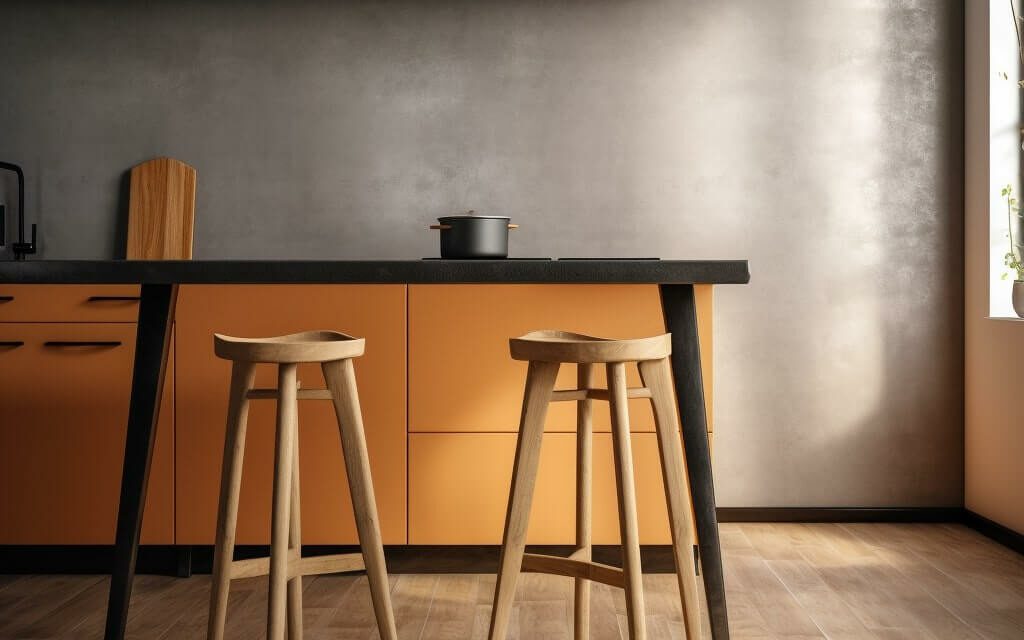
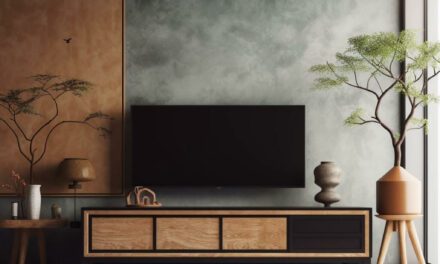
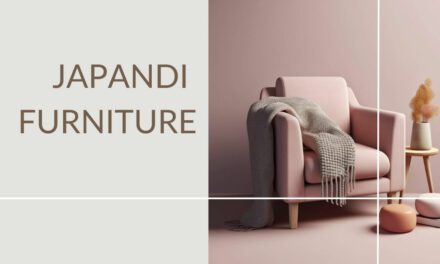
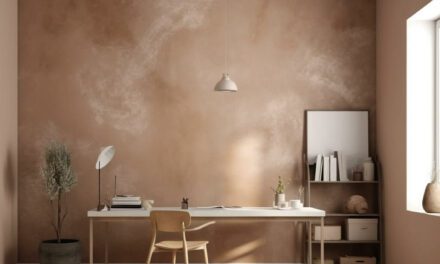
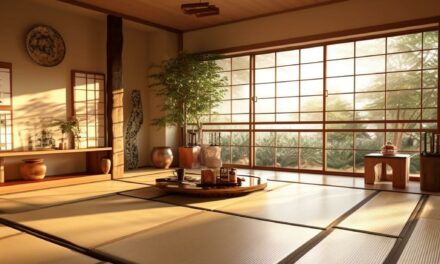
Wonderful, what a web site it is! This weblog presents helpful facts to us, keep it up.
Thanks!
Keep on writing, great job!
Hey there! This post couldn’t be written any better!
Reading through this post reminds me of my old room mate!
He always kept chatting about this. I will forward this post to him.
Pretty sure he will have a good read. Thank you for sharing!
Very nice post. I certainly appreciate this website.
Continue the good work!
Pretty great post. I simply stumbled upon your blog and wished
to say that I’ve really loved browsing your blog posts.
In any case I will be subscribing to your feed and
I am hoping you write once more very soon!
Awesome blog! Is your theme custom made or did you download it from somewhere?
A design like yours with a few simple tweeks would really make
my blog shine. Please let me know where you
got your theme. Appreciate it
Hi it is Divi theme 🙂
Hello! I could have sworn I’ve been to this website before
but after reading through some of the post I realized it’s
new to me. Anyways, I’m definitely glad I found it and I’ll be book-marking
and checking back often!
This design is spectacular! You most certainly know how to keep a reader amused.
Between your wit and your videos, I was almost moved to start
my own blog (well, almost…HaHa!) Wonderful job.
I really enjoyed what you had to say, and more than that, how you presented it.
Too cool!
I’m not that much of a online reader to be honest but your
blogs really nice, keep it up! I’ll go ahead and bookmark your
site to come back in the future. Cheers
I do not even know how I ended up here, but I thought this post was
good. I don’t know who you are but definitely you are going to
a famous blogger if you aren’t already 😉 Cheers!
I couldn’t resist commenting. Perfectly written!
Good article. I definitely appreciate this site.
Keep it up!
Hello! Someone in my Facebook group shared this site with us so I came to look it over.
I’m definitely enjoying the information. I’m bookmarking and will be tweeting
this to my followers! Excellent blog and fantastic design and style.
Very good article. I will be facing some of these issues
as well..
Whoa! This blog looks exactly like my old one! It’s on a totally different topic but it has pretty much the same layout
and design. Outstanding choice of colors!
I’m really enjoying the design and layout of your blog.
It’s a very easy on the eyes which makes it much more
enjoyable for me to come here and visit more often. Did you hire
out a developer to create your theme? Exceptional work!
Nice blog! Is your theme custom made or did you download it from somewhere?
A design like yours with a few simple tweeks would really make my blog stand out.
Please let me know where you got your design. Appreciate it
Thanks, it’s Divi theme design 🙂
I think that everything said was very logical.
But, what about this? suppose you typed a catchier title?
I ain’t suggesting your content is not solid, but suppose you added something to possibly grab folk’s attention? I mean Japandi Bar Stools
– 13 Examples for a Zen Kitchen Design is kinda boring.
You ought to look at Yahoo’s home page and see how they
create article titles to get viewers to click.
You might add a related video or a pic or two to grab people excited about what you’ve written.
In my opinion, it could bring your blog a little bit more interesting.
Thanks for the tips 🙂
Hi there I am so happy I found your web site, I really found you by accident, while I was looking on Aol for something else, Nonetheless I am here now and would just like to say kudos for a fantastic post and a
all round thrilling blog (I also love the theme/design), I don’t have time to go through it all at the
minute but I have bookmarked it and also added in your RSS
feeds, so when I have time I will be back to read a lot more,
Please do keep up the great work.
Thanks! I love the design too
Your style is very unique compared to other people I have read stuff from.
I appreciate you for posting when you have the opportunity, Guess I will just book mark
this page.
Thanks designed for sharing such a nice thought, piece of writing is nice, thats why i have read it entirely
Thanks!
I absolutely love your website.. Great colors & theme. Did you
make this web site yourself? Please reply back as I’m hoping to create my very own blog and want to
know where you got this from or juszt what the theme is named.
Many thanks!
My web page: 币安交易手续费
Hi, it’s the Divi theme design. Thanks for your feedback